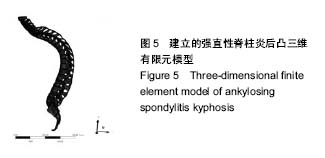| [1] Braun J,Baraliakos X,Godolias G, et al. Therapy of ankylosing spondylitis-a review. Part I: Conventional medical treatment and surgical therapy.Scand J Rheumatol. 2005;34(2):97-108. [2] Zhang H, Zhou Z, Guo C, et al. Treatment of kyphosis in ankylosing spondylitis by osteotomy through the gap of a pathological fracture: a retrospective study. J Orthop Surg Res. 2016;11(1):136. [3] 李庆,曾勇,石化洋,等.手术治疗强直性脊柱炎脊柱后凸伴髋关节强直并重度屈曲挛缩的效果观察[J].实用医院临床杂志,2015, 12(5): 153-155. [4] Debarge R, Demey G, Roussouly P. Sagittal balance analysis after pedicle subtraction osteotomy in ankylosing spondylitis. Eur Spine J. 2011;20(5): 619-625.[5] Y?ld?z F, Akgül T, Ekinci M, et al. Results of closing wedge osteotomy in the treatment of sagittal imbalance due to ankylosing spondylitis. Acta Orthop Traumatol Turc. 2016; 50(1):63-68.[6] Qian B, Jiang J, Qiu Y, et al. Radiographical predictors for postoperative sagittal imbalance in patients with thoracolumbar kyphosis secondary to ankylosing spondylitis after lumbar pedicle subtraction osteotomy. Spine. 2013; 38(26): E1669-E1675.[7] Wang MY, Bordon G.Mini-open pedicle subtraction osteotomy as a treatment for severe adult spinal deformities: case series with initial clinical and radiographic outcomes. J Neurosurg Spine. 2016;24(5):769-776.[8] Behari S, Tungeria A, Jaiswal AK, et al.The" moustache" sign: Localized intervertebral disc fibrosis and panligamentous ossification in ankylosing spondylitis with kyphosis. Neurology India.2010;58(5): 764.[9] Burstein AH, Reilly DT, Martens M.Aging of bone tissue: mechanical properties. J Bone Joint Surg Am.1976;58(1): 82-86. [10] Shirazi-adl SA, Shrivastava SC, Ahmed AM. Stress Analysis of the Lumbar Disc-Body Unit in Compression A Three-Dimensional Nonlinear Finite Element Study. Spine. 1984;9(2):120-134.[11] Shirazi-Adl A, Ahmed AM, Shrivastava SC. A finite element study of a lumbar motion segment subjected to pure sagittal plane moments.J Biomech. 1986;19(4):331-350. [12] 钱邦平,胡俊,邱勇,等.强直性脊柱炎胸腰椎后凸畸形患者生存质量与矢状面参数的相关性[J].中华骨科杂志, 2014, 34(9): 895-902.[13] 刘辉,郑召民,李思贝,等.脊柱-骨盆曲线和谐角在脊柱畸形矢状面评价中的应用[J]. 中华骨科杂志, 2014,34(8):831-838.[14] 宋凯,张永刚,郑国权. 强直性脊柱炎后凸畸形矫形前后生活质量与影像学参数分析[J].中华骨科杂志, 2012, 32(5):404-408.[15] Belytschko T, Kulak RF, Schultz AB, et al.Finite element stress analysis of an intervertebral disc.Biomech. 1974;7(3): 277-285.[16] Aubin C E, Descrimes J L, Dansereau J, et al. [Geometrical modeling of the spine and the thorax for the biomechanical analysis of scoliotic deformities using the finite element method][C]//Annales de chirurgie.1994;49(8): 749-761.[17] Pitzen T,Pedersen K,Matthis D,et al.[Is the prediction of initial stability of cervical spinal osteo-synthesis possible using a finite element model?]. Zentralbl Neurochir.1999;61(3): 133-137.[18] Sadegh AM, Tchako A.Vertebral stress of a cervical spine model under dynamic load.Technol Health Care.2000;8(2): 143-154.[19] Pan YN, Li AJ, Chen ZQ, et al.Improved image quality and decreased radiation dose of lower extremity computed tomography angiography using low-tube-voltage and adaptive iterative reconstruction.J Comput Assist Tomogr.2016;40(2): 272-276. [20] 吴继彬,郭开今,袁峰,等.经腰椎椎弓根椎体截骨术治疗强直性脊柱炎后凸畸形[J].中国矫形外科杂志,2015, 23(23): 2128-2132.[21] 陈志明,杨滨,马华松,等.双椎体截骨术矫正强直性脊柱炎重度胸腰椎后凸畸形[J].中国脊柱脊髓杂志,2014, 24(4): 326-332.[22] 林斌,张毕,许洋,等.脊柱去松质骨化截骨术治疗强直性脊柱炎并脊柱后凸畸形[J].临床骨科杂志,2014,17(3): 241-244.[23] Van Royen B J, De Gast A. Lumbar osteotomy for correction of thoracolumbar kyphotic deformity in ankylosing spondylitis. A structured review of three methods of treatment.Ann Rheum Dis.1999;58(7):399-406.[24] 宋凯,张永刚.强直性脊柱炎胸腰段后凸畸形矫形设计概述[J]. 解放军医学院学报,2015,36(5): 521-524.[25] 钱邦平,邱勇,潘涛,等.经椎弓根不对称截骨重建强直性脊柱炎胸腰椎侧后凸畸形患者双平面平衡[J]. 中华骨科杂志, 2015, 35(4):341-348.[26] 宋凯,张永刚,李杰静,等.肺门作为躯干重心对强直性脊柱炎胸腰段后凸畸形矫形的意义[J].中国骨与关节杂志,2014,3(10): 012.[27] 张文生,郑闽前,邹国友,等.强直性脊柱炎胸腰椎骨折手术方法的选择[J].中华创伤骨科杂志, 2012, 14(9): 778-781.[28] 曾岩,仲强,郭昭庆,等.强直性脊柱炎后凸畸形的后路截骨矫形术及疗效分析[J].中华外科杂志, 2010, 48(16): 1234-1237.[29] 曹参,吴继功.后路脊柱截骨矫形术的临床应用进展[J]. 实用骨科杂志,2013,19(1): 44-47.[30] 尹刚辉,金大地,陈方尧,等.新的脊柱-骨盆矢状面测量参数: 骶骨骨盆角的提出及意义[J].中国脊柱脊髓杂志, 2014, 24(8): 704-709. |
.jpg)

.jpg)
.jpg)
.jpg)
.jpg)
.jpg)